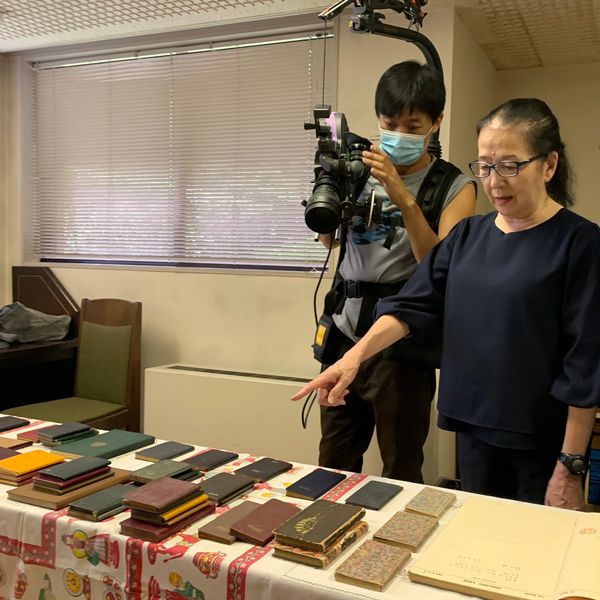
Contacts & Festivals
World Sales - Shochiku Co., Ltd.
Festival Inquiries - Kathy Susca
Press Inquiries - Yuki Machida
Recent Festivals
• Venice Film Festival (World Premiere) – Sept 2, 2025
• Busan International Film Festival (Wide Angle, Asian Premiere) – Sept 21, 2025
• Rio de Janeiro International Film Festival (Latin American Premiere) – Oct 2025
• AFI FEST (North American Premiere) – Oct 23, 2025
• Tokyo International Film Festival (Japan premiere)– Nov 2, 2025
• Golden Horse Film Festival (Taiwan Premiere) – Nov 6–23, 2025
Critical Praise
“The Ozu Diaries can be regarded as the definitive documentary about Ozu’s life and work. At last, Yasujiro Ozu receives the comprehensive and poetic cinematic portrait he deserves.” —Ritter Fan, Plano Crítico
“A film to be savored patiently, much like Ozu’s own masterpieces.” —Marco Fialho, Cinefialho
“The Ozu Diaries is a true labor of love, faithful to Godard’s statement that ‘editing is the resurrection of life.’” —Marcella Leonardi, Nubi Fluttuanti

BEHIND THE SCENES
Filming the Ozu's diaries at the Kamakura Museum of Literature with Akiko Ozu (Yasujiro Ozu’s niece)

BEHIND THE SCENES
An insightful interview with master filmmaker Wim Wenders (WINGS OF DESIRE, PERFECT DAYS), reflecting on Yasujiro Ozu's enduring legacy.

BEHIND THE SCENES
From left to right (top row): Hiromi Fujii (Shochiku Executive), Yuki Machida (producer), Daniel Raim (director/producer), Matt Severson (creative consultant), Koichi Furuya (cinematographer),
(bottom row) Yukiko Wachi (Head archivist from the Kawakita Memorial Film Archive), Kyoko Kagawa (actress, "Tokyo Story"), and Takuya Kawakami (sound recordist).
About THE FILM
THE OZU DIARIES, from Academy Award®-nominated filmmaker Daniel Raim, offers both an intimate biography and revelatory portrait of prolific Japanese master Yasujiro Ozu, one of cinema’s most original and enduring auteurs. Drawing from a treasure trove of archival materials — journals, notebooks, correspondence, photographs, interviews and unseen home movies — the film opens a rare window into Ozu’s inner world and artistic process. With Ozu’s own words as guide, and enriched by reflections from filmmakers Wim Wenders, Kiyoshi Kurosawa, Tsai Ming-liang, Luc Dardenne and others, Raim traces how Ozu’s personal life informed his work, creating cinematic masterpieces such as LATE SPRING, TOKYO STORY and AN AUTUMN AFTERNOON to name a few. His precise, deceptively simple stories and signature visual style became a vehicle for poetic, humanist explorations of family, love and impermanence. Deeply rooted in Japanese culture yet universally resonant, Ozu’s work continues to shape our understanding of cinema’s possibilities.
Director's Statement: Ozu's films didn't come easily to me at first. But his poetic portraits of family life and loneliness lingered. An Autumn Afternoon became the gateway, not through plot or drama, but through presence. As Kiyoshi Kurosawa says in this documentary, "Watching Ozu for the first time, I felt I was glimpsing the very secret of cinema itself." In 2017, while making a short film for The Criterion Collection titled In Search of Ozu, I sensed a deeper story waiting to be told: the human being behind the films. The most challenging part was confronting Ozu's wartime experience. His diaries from that period and postwar interviews reveal a rupture - a profound loss. As Masasumi Tanaka wrote, "Ozu survived the war. But we cannot deny that his humanity was in crisis." And yet, in the decades that followed, he created some of the most tender, humorous, formally playful, and emotionally resonant films in cinema. This documentary is told largely in Ozu's own words. It's an attempt to sit with him across time - to understand his pain, his joy, his contradictions, and his singular way of seeing the world.
Crew
Written, Directed & Edited by: Daniel Raim
Produced by: Yuki Machida, Daniel Raim
Director of Photography: Koichi Furuya
Original Music: Dave Lebolt
Executive Producers: Matthew & Natalie Bernstein, Hiromi Fujii, Charlie Tabesh, Eric Nyari
Featuring
Kiyoshi Kurosawa, Wim Wenders, Luc Dardenne, Isao Shirosawa, Michiko Yamanouchi, Tsai Ming-liang, Kyoko Kagawa, Akiko Ozu, Shizuo Yamanouchi
Voices
Yasujiro Ozu – Koi Ohori
Shiro Kido & others – Rin Takagi
Kinuyo Tanaka & Asae Ozu – Kie Nakai
Archivists
Yukiko Wachi, Kazuhiro Odashima, Hidenori Okada
With support from Kawakita Memorial Film Institute, Kamakura Museum of Literature, National Film Archive of Japan
Made in Association With
Turner Classic Movies (TCM)
Shochiku
Office OZU
Ozu and Noda photo credit: © 2025 Adama Films; photo: Shochiku Co. Ltd.

SUPPORT THE PROJECT
We are fortunate to have The Film Collaborative, a 501 (c)(3) organization as the Fiscal Sponsor for THE OZU DIAIRIES Documentary Project. If you’d like to make a TAX-DEDUCTIBLE DONATION to help us finish film, please click the "DONATE" button below.
